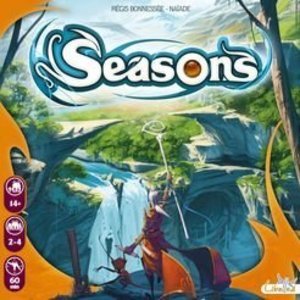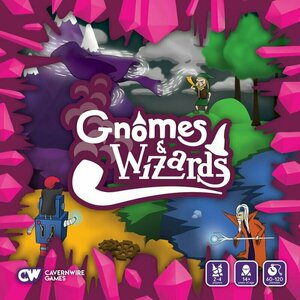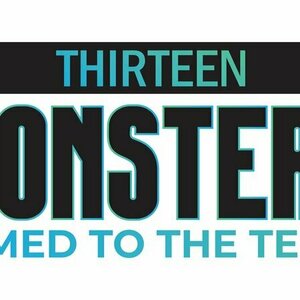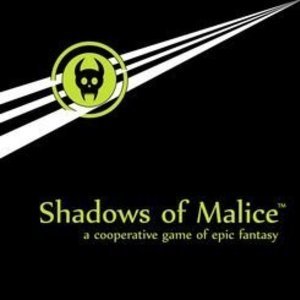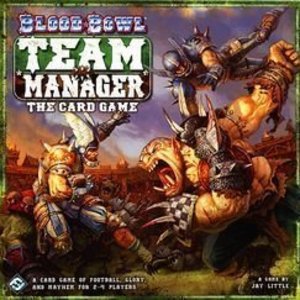
Blood Bowl: Team Manager – The Card Game
Tabletop Game
Blood Bowl: Team Manager - The Card Game is a bone-breaking, breathtaking standalone card game of...
Boardgames DeckBuilding BloodBowl
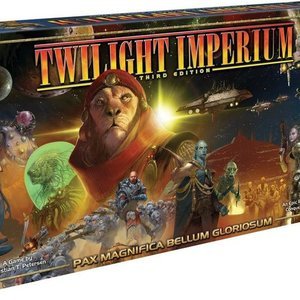
Twilight Imperium Third Edition
Tabletop Game
Twilight Imperium Third Edition is an epic empire-building game of interstellar conflict, trade, and...
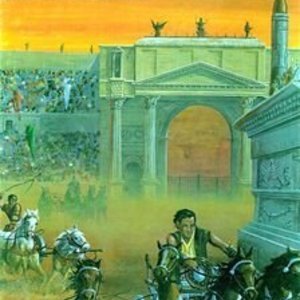
Circus Maximus
Tabletop Game
"The grandeur and decadence of ancient Rome in your living room! Thrill to the dust of chariot...
BoardGames RomeGames ChariotRacing GladiatorGames RacingGames
Purple Phoenix Games (2266 KP) rated Seasons in Tabletop Games
Jul 6, 2019 (Updated Nov 4, 2021)
Seasons is a fantastical dice rolling, card drafting, hand management game for two to four players. In it, players are sorcerers competing in a legendary magical tournament that spans three years in an attempt to be crowned the next Archmage of the kingdom. As the seasons change, sorcerers may draw power from changing mana sources, and utilizing these sources most efficiently and effectively will earn victory over all. So tighten up your belt and get to casting, young mage!
To setup, follow the rules in the rulebook (there are many steps, and I have feeble and weak fingers) until the table looks somewhat similar to the photo below – except for the obvious oversight in placing the orange cube on the zero space of bonus actions. The main areas of interest are the main game board where the years and seasons are tracked, the Crystal score track, and player board/tableau area. Players will be dealt a hand of nine cards to start, and then draft one card at a time, passing to their neighbor each time, and deciding which three cards they would like to start the game with, and assigning three more cards each into the Library for rounds two and three. The game begins in Winter, and the black cube is placed on the number 1 of the seasons board. The game is now setup and ready to begin with the first player!
Each turn the active player will roll all dice in the current season (this game is setup for two players, so three total dice are used each turn). They will choose one die to use for the turn, and other players will choose theirs. The players then gather the resources present on the die face. These could be element tokens, crystals (VP), summon gauge stars, cards drawn from the deck, or even transmutation powers. Once resources are gained, the active player may then choose to play a card from their hand to their personal tableau, given they have adequate summoning power (the number of cards that can be played) available on their board. The cost to play the card is found under the illustration, and is usually paid in crystals, element tokens, or a combination of both. These Power Cards may allow the player immediate benefits, ongoing benefits, or benefits that may be activated at certain times during the game.
Another option players have from their chosen die is the ability to transmutate. When a player chooses a die with this option, they are able to consult the current season on the main board and exchange element tokens for crystals, depending on the provided exchange system. For example, a player wishing to exchange earth tokens (the green plant) during Winter will be provided with three crystals each, while attempting the same transmutation during Spring will only provide one crystal each.
Once each player has taken their turn to collect their resources, complete their turn actions, and pass onto the next player, the unchosen die is resolved. Each die face also shows a number of dotted pips at the bottom. The number of pips shown on the unchosen die refers to the number of spaces the cube on the main board season tracker is to be moved forward around the board. One pip, one space forward. This could result in the current season continuing or progressing into the next season. When the cube progresses from Fall to Winter, players will collect their cards set aside for year two or three, respectively. These cards are added to their hand and available to be used immediately on their turn. If, however, on their turn a player has little they can do, or simply wish to boost their turn, they may use one of four bonus actions, as printed on their player board. These actions allow the player to trade two element tokens from their reserves for any other two element tokens from the main supply, allow transmutation if the symbol is not present on their chosen die face, increase their summoning gauge by one, or draw two power cards from the deck and choose one to add to their hand instead of drawing one, per their die face. Each player can use three total bonus actions for each game at a cost of crystals for each usage. Certainly a trade-off.
Play continues in this fashion of choosing and resolving dice, playing cards, and transmuting tokens for crystals until the cube has completed its three year journey around the main board. At that time crystals are scored from cards and added to the tracker, with five points deducted for each card remaining in hand and points deducted for the usage of bonus actions. The player with the most crystals at the end of the game is the winner!
Components. I have a lot to say here, but will attempt to be as succinct as I can. The components in Seasons are simply phenomenal. Yes, the boards, cards, and cubes are all fine quality and unimpressive. However, the art style throughout the game and those big chunky dice are the real standouts to me. I mean, who DOESN’T like to roll big, chunky dice? And the player colors? Oh man, I love them! Players can choose orange, purple, gray, or lime green. Those are some great color options, and such a simple upgrade from primary colors used on many other games. The dice are primary colors, but I still enjoy them and I will let it slide. No real complaints on components from me. I have heard complaints about people not vibing on the color choices associate with the elements/energy, but I applaud the mold-breaking here. Why can’t Fall be red and associated with a feather? Why can’t Summer be yellow and associated with a flame? Fire doesn’t always have to be red. Go on, Seasons! Be you!
Our thoughts on each game should never be a surprise. I will say this for Seasons – I believe that when I auctioned it off the first time, part of the reasoning was because I did not fully understand the rules. I was a newer gamer at the time and was lured in by colors and art style (which are still stunning). More than likely I thought I was smarter than I truly am and included all the cards in my first plays instead of heeding the suggestions given by the rulebook for easier first games. Now, being a more seasoned (I couldn’t resist) gamer, I can better appreciate what is in this box. The unique card play, the dice drafting for resources and actions, the progression of time as a result of the rejected die, all come together to make a very solid and different game. I am trying to think my way through my collection to find a parallel that uses all these mechanics together as well as Seasons does and I am finding it difficult. It is so easy to just throw mechanics into a blender and see the goo that results, but everything with Seasons feels right and I am just in love.
Why did I ever get rid of Seasons? I will claim young and dumb, though I wasn’t very young. Do not emulate my decision to shed this one out of your collection. You don’t have a copy? I would recommend visiting your FLGS to see if they might have a copy in stock. It’s a great one, and one that I will treasure from here on out. Purple Phoenix Games officially gives this one an amazingly colorful 5 / 6. I know the others will enjoy it too, but until they play it, I will be giddy with excitement each time I am able to play my copy. Why are you still here? Go get Seasons!
Purple Phoenix Games (2266 KP) rated Gnomes & Wizards in Tabletop Games
Jan 21, 2020
Gnomes & Wizards is an area control, map deformation, dice assignment battle game where the players are attempting to earn the most victory points (VP) at the end of the game. Players gain VP by defeating other players’ active characters (clan leaders and tribesmen henchpeople), and having the most hit points (HP) between all their active characters at game end. Sounds easy, right? Read on, my friend.
DISCLAIMER: We were provided a prototype copy of this game for the purposes of this review. These are preview copy components, and the final components will probably be different from these shown. Also, it is not my intention to detail every rule in the game, as there are just too many. You are invited to download the rulebook from the publisher’s website, purchase the game through the Kickstarter campaign, or through any retailers stocking it after fulfillment. -T
As I mentioned in my disclaimer, I will not be explaining every rule for this one as there are quite a few little nuances that make it tick. However, I will cover the basic gameplay, and I will be focusing on a 2-player game for this preview.
To setup the game, each player receives all the components in their chosen color for their clan. A clan consists of a leader (which is represented by the cone on the board) and six tribesmen (henchpeople represented by discs with their specific icon). The board is an elaborate puzzle of triangular pieces that fit together beautifully and create a very interesting map on the table. In the middle of this puzzle map will always be the mine tiles – tiles that have pink power crystals outlining the inner icons. Each leader will have clips placed on their cards to keep track of HP and Defense, and these cards also show baseline movement speed and attack power. Once all players have completed their setup and the black dice have been rolled to determine the starting player, the game is ready to begin and the crystals are primed to be exploited.
Gnomes & Wizards is a game of dice manipulation and allocation at its core. Leaders and tribesmen will always have base movement, attack, defense, and HP, but the dice rolls can alter these. Perhaps you are a super-aggressive player and are just out to destroy the other clan(s). I have played that way and it works very well. If so, then when rolling you will want to concentrate your efforts on the move/attack die face. These add to either your movement speed or to your attack power (not both). Other die faces include defense (which raise your defense clip), horns (which can buy you an ability card OR help to call a tribe – more on this later), or collect power crystals.
Power crystals are used to charge clan abilities (printed on the clan board) and card abilities (attached to clansmen). You can earn your power crystals via die rolls or by passing through the mine tiles in the center of the board map. These power crystals, and the abilities they fuel, are very powerful and can make or break encounters against other clans.
Horns are what need to be rolled to bring more tribesmen on the board. Initially, each clan will only have the leader cones available on the board to play with until more tribesmen can be called to the fray. Rolling three horns and having a leader cone or tribesman disc on tribe-specific icon tiles will allow that tribe to be called onto the board. Did you only roll one or two horns? That’s okay, because horns are also used to draw ability cards from the deck. Draw as many cards as you have rolled horns and choose one of those to keep and the others are discarded to the bottom of the deck. You may attach certain ability cards to your clansmen to be charged by power crystals and used later, or keep certain other cards hidden in your stash to be used any time – even on another player’s turn.
The winner of Gnomes & Wizards is the player who earns the most VP by knocking out opponent clansmen/leaders and earning 1VP per HP remaining on active clansmen cards. I purposely left out a couple twists for you here. Your gameplan needs to be carried out in just 10 rounds in a normal game. So you only have 10 turns to create your all-star clan, earn power crystals, and beat up your opponents. Not enough? Okay how about this – after Round 5 each player will flip over two map tiles at the beginning of their turns – thus eliminating possibilities of calling clansmen to war because their icon is now flipped and unavailable. Each turn is incredibly important to maximize as best as possible as you only get 10 of them, and the map will begin to crumble away.
Components. Again, we were provided a prototype version of the game, so I will not comment on component quality, even though it’s already pretty good. I can see what CavernWire is trying to do here and I am very excited by the plans. The layout on the cards is great. The dice will be cool when final. The amazing power crystals will be a little fragile, so do take care of them, but the design is awesome. The best part about the components on this one – the colors. This game is so wonderfully colorful, and extremely attractive on the table. When playing at work, my coworkers all walked by the table and wanted to know what I was up to. I play games at work a lot, but this one was so vibrant and interesting that they wanted to know more – and they are all mostly non-gamers.
I find Gnomes & Wizards to be a game that I wish I could spend lots of time exploring every strength and weakness of each clan. Trying new strategies, and watching them be dismantled by newcomers. I have not seen every ability card yet. I have not played with each clan yet. But I want to. It’s a deeply colorful game with engaging mechanics (and lots of them) that I feel offers something special to a game collection. So if you are interested in grabbing a copy for yourself, head over to CavernWire’s website and hop on the Kickstarter campaign. Or purchase a copy from your FLGS or favorite online retailer. We dig it.
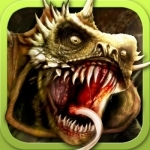
Fighting Fantasy: The Forest of Doom
Games and Book
App
Nostalgia overload! Fighting Fantasy returns with Ian Livingstone's classic, The Forest of Doom. ...
Purple Phoenix Games (2266 KP) rated 13 Monsters Armed to the Teeth in Tabletop Games
Sep 22, 2020 (Updated Sep 22, 2020)
13 Monsters Armed to the Teeth (which I will call “the expansion” from here) is a big expansion to the successful 13 Monsters that recently fulfilled their Kickstarter campaign rewards. I was lucky enough to be able to preview OG 13 Monsters, and I suggest you take a look there before continuing on if you aren’t familiar with the base game. 13 Monsters can be summed up as, “a game of Memory where you use the pieces you’ve matched to battle your opponents.” Once you add in the expansion, though, the description takes on new veribiage, “a game of Memory where you use the pieces you matched along with enhancement items like weapons, shields, new abilities, and a new elemental species to decimate your opponents.” Intrigued?
DISCLAIMER: We were provided a prototype copy of this game for the purposes of this review. These are preview copy components, and I do not know for sure if the final components will be any different from these shown. Also, it is not my intention to detail every rule in the game, as there are just too many. You are invited to download the rulebook, back the game through the Kickstarter campaign, or through any retailers stocking it after fulfillment. -T
Setup will be the same as base 13 Monsters but with added components to lay on the table. These include a big mini (is that a thing?) of a new character named Trall, new black dice, weapon tiles, shield tiles, Metal monster tiles, and durability counters for the weapons and shields. Once all these items are added the base tile grid the game may begin!
Now, I won’t go into detail how to play base 13 Monsters, but rather give an idea of what the expansion adds. Trall is a smithy who is intrigued by new monstersets matched and added to a player’s tableau, so he will come visit that player once a match is made. On one’s turn, if Trall is visiting, he will allow the player to Forge an item (weapon, shield, or Metal monster tile) by rolling the black dice and taking a tile from the specific pile, or Steal an item from another player by winning a roll-off of the new black dice.
The new abilities given to players are numerous and include names like All Seeing Eye and Oopsie Poopsie. I will leave you to the rulebook to discover all the new abilities.
Obviously, when players attach weapons to a monster they will be able to increase their attack power, but will also have to account for hits in durability using the small counters. Similarly, durability counters are included for the shield tiles that assist in deflecting portions of attacks from opponents.
The Metal monsters are part of a new elemental species of monster and are helpful, but worth less VP at the end of the game.
Components. If you have or know of the component quality in base 13 Monsters, then you will be glad to know that the components in the expansion are just as good if not better. When I opened the box the first thing I grabbed for was the Trall mini. He’s a big guy and while the prototype version is a 3D printed mini, I have seen photos of a cardboard standee in a box (however, my money is on a resin mini of Trall as a stretch goal). The weapon, shield, and Metal monster tiles are the same quality as the base tiles so it’s a match there. The new dice are black with white print, which contrast nicely with the base game’s pink dice and white pips. All in all the production quality is great, even in the prototype!
So is this expansion good or necessary or bad or what? Well, let me state the obvious first: if you are happy with how base 13 Monsters plays, then you do not need this expansion. If you want a lot more meat from your game, then this expansion is absolutely necessary. It adds so many more layers of complexity onto a somewhat harmless base game. Yes, there is battle in the base game and stealing of monstersets, but to me it seems it hurts way more using the expansion because you can spend lots more time buffing up your monsters with the extra battle accessories and such to have them just pilfered away.
That still doesn’t answer if I think 13 Monsters Armed to the Teeth is good. Here are my negative points off first. Adding in the expansion content will most certainly add length to the gameplay as well, especially with higher play counts. Players have a ton of options available on a turn now and though some events will be triggered via dice rolls, the new abilities will adjust how players play this versus just the base. A game can now be well over two hours depending on how players play and which type of players are playing. To help combat this, the rulebook advises ways of reducing game time by 50% and I highly suggest you take that advice. I did and games are still around 90 minutes with players who know how to play.
On the positive side, though, there’s more 13 Monsters goodness in this box! And while I do not classify this as “more of the same,” I enjoy more 13 Monsters goodies. This definitely amps up the pressure for each turn and players are involved at all times. Now, I will not be using the expansion when pulling out the game with new players or when I might use 13 Monsters as a gateway game. The expansion just adds too much complexity. But, after a couple plays of the base game, go ahead. Throw it in and watch the eyes widen in anticipation.
So yes, 13 Monsters Armed to the Teeth is a great expansion to a great game. If you like 13 Monsters and want to add more complexity and options, then definitely pick up this expansion. If you missed out on backing 13 Monsters last time, maybe the team at Twisted Stranger will offer them during the next campaign for this expansion. I am quite happy to be adding this to my collection and I know it will see lots of table time for me. Good job team! Now go obliterate your friends! I mean, their monsters.
Paul Kellett (118 KP) rated Shadows of Malice in Tabletop Games
May 8, 2019
Instead, you get plain cards with simple line art and either just an icon/dice modifier or a short line of text explaining the effect. These cards are items of armour, weapons or other loot, potions, skill masteries, fate effects or abilities. A selection of these make up your character. Again, there are no defined heroes, you can be whatever you fancy being.
When you encounter a monster you roll 3d6 against a chart which will define the creature's species and its strength. Creature types are things like "Avian" and "Reptilian" so you can imagine fighting a dinosaur, a giant eagle or whatever fantastic creature you desire.
This makes the game a great framework to roleplay in. You are never stuck encountering the same things again and again. On the minus side, if you don't have a good imagination, it boils down to just rolling dice and beating target numbers. If you want a game to give you a story to follow, SoM is not that game.
The rules are good, if a little heavy but after a game or two it should soon click and it's mostly straight forward. The designer has recently just uploaded a revised rulebook to BGG which streamlines a number of things.
SoM comes with 4 large landscape hex tiles plus a shadow realm tile and you can choose any number of tiles to arrange in any position around the shadow realm tile. Each tile is divided into a number of smaller hexes with varying terrain and locations printed on them. This is the world you will be exploring and, despite being tiny compared to other game boards, each tile adds about an hour to the play time.
Gameplay involves exploring the land fighting creatures, gaining loot, visiting cities to trade goods or mystic seers to buy potions while searching for the special light wells that you must take control of.
In between player turns, the shadows act. They begin confined to the shadow realm but as the rounds progress, barriers fall and the shadows are more likely to find a way out to manifest in the land. Once there they start searching for the light wells and it's game over if they get to them first .
This makes for a tense cat and mouse with your heroes racing to either get to a well or intercept the demons on route.
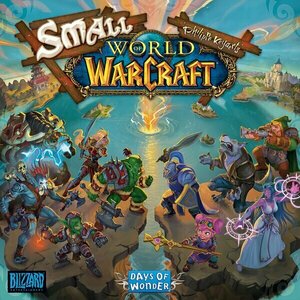
Small World Of Warcraft
Tabletop Game
In Small World of Warcraft, players vie for conquest and control of a world that is simply too small...
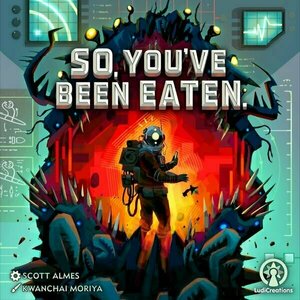
So, You've Been Eaten.
Tabletop Game
So, you’ve been eaten. Don’t worry, this is simply an occupational hazard. In fact, it is...
